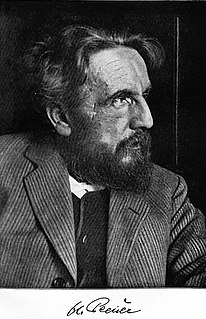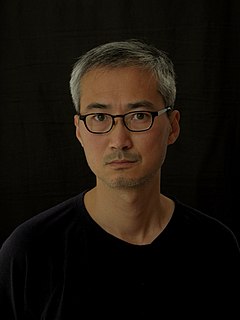
Christian Adam Landenberger (7 April 1862, Ebingen - 13 February 1927, Stuttgart) was a German Impressionist painter and a professor at the State Academy of Fine Arts Stuttgart. He is especially known for his landscapes. [1]

Christian Adam Landenberger (7 April 1862, Ebingen - 13 February 1927, Stuttgart) was a German Impressionist painter and a professor at the State Academy of Fine Arts Stuttgart. He is especially known for his landscapes. [1]

He was the second in a family of nine children. His parents operated a haulage business. He began his art studies at the Royal Art School of Stuttgart in 1879. From 1883 to 1887, he studied at the Academy of Fine Arts Munich, where he had his first exposure to the new ideas in art that were circulating there. [1]
In 1890, he had his first public display at the Munich International Art Exhibition in the Glaspalast and, two years later, became one of the founding members of the Munich Secession. [2] He exhibited regularly until 1916. In 1895, he started a private art school and taught drawing at the Munich Association of Women Artists from 1899 to 1905. At that time, he became a professor at the State Academy of Fine Arts in Stuttgart. [2]
At first, he created realistic canvases using a dark palette. After 1890, he used brighter colors with lighting effects and broad brushstrokes. He is considered to have been one of the pioneers of German plein-air painting. From 1893 to 1915, he worked on a themed series of paintings he called "Bathing Boys". [1] His landscapes were accomplished in Norway and along the Dutch sea coast as well as in Southern Germany. After 1919, he began to produce etchings of a religious nature.

The municipal art museum in Albstadt, Germany (Kunstmuseum Albstadt) has the largest collection of his work, with over 70 paintings, 200 drawings and 160 pages of print graphics.

Lovis Corinth was a German artist and writer whose mature work as a painter and printmaker realized a synthesis of impressionism and expressionism.

Günther Förg was a German painter, graphic designer, sculptor and photographer. His abstract style was influenced by American abstract painting.
Michael Buthe was a German artist who lived and worked between Germany and Morocco. He exhibited widely throughout Europe during his life and is known for his eclectic and prolific oeuvre which encompasses painting, sculpture, and installation.

Willi Baumeister was a German painter, scenic designer, art professor, and typographer. His work was part of the art competitions at the 1928 Summer Olympics and the 1932 Summer Olympics.

Heinrich Altherr was a Swiss painter. He is best known for his murals in churches and various public buildings.

Ian McKeever is a contemporary British artist. Since 1990 McKeever has lived and worked in Hartgrove, Dorset, England.
Max Uhlig is a German painter. He won the Hans Theo Richter-Preis of the Sächsische Akademie der Künste in 1998.

Hermann Pleuer was a German Impressionist and landscape artist who is best known for his paintings of the Royal Württemberg State Railways.

Byung Chul Kim is a South Korean artist based in Germany since 2004. He works in performance, drawing, painting and video.
Georg Karl Pfahler was a German painter, printmaker and sculptor, and one of the leading proponents of post-war art in Germany.
Norbert Prangenberg was an abstract painter, sculptor, and engraver who was born in Nettseheim, just outside of Cologne, Germany. Though he had no formal training and did not fully engage with art until his 30s, Prangenberg did finally come up with a style that was uniquely his own, not fitting comfortably into the neo-expressionist or neo-geo movements of his time, in the 1970s and 1980s. At this time, he was considered a major figure in contemporary German art. Though he got his start with abstract paintings, he also became known for making sculptures of all sizes; and while his work initially appears abstract, the titles given sometimes allude to the human body or a landscape. As a trained gold- and silversmith, as well as a glassblower, he always showed an attention to materials and how they could be physically engaged with. He was interested in how his own two hands could affect the painting or sculpture's surface. Traces of the artist's hand appear literally throughout his entire oeuvre, before he lost the battle with liver cancer in 2012.
Wolfgang Kermer is a German art historian, artist, art educator, author, editor, curator of exhibitions and professor. From 1971 to 1984 he was repeatedly elected Rector of the State Academy of Fine Arts Stuttgart and thus the first scientific and at the same time youngest teacher in this position in the history of the university. Under his rectorate, the State Academy of Fine Arts Stuttgart was reformed in 1975 and 1978 on the base of two new university laws of the State of Baden-Württemberg and thus, for the first time in its history, authorized to set up diplomas for all courses. His focus is the history of Visual arts education, the art of Willi Baumeister and the history of the State Academy of Fine Arts Stuttgart and its predecessor institutions. He was the publisher and editor of the publication series Akademie-Mitteilungen (1972–1978), Beiträge zur Geschichte der Staatlichen Akademie der Bildenden Künste Stuttgart (1975–2004), WerkstattReihe (1996–2006) and ″Die Staatliche Akademie der Bildenden Künste Stuttgart im Spiegel der Presse 1970/1971″ (2008). On the occasion of his 75th birthday, the Stuttgarter Nachrichten called Wolfgang Kermer ″the memory of the Stuttgart Art Academy″.
Rudi Tröger is a German painter and university professor. From 1967 to 1992 he was a professor for painting art at the Academy of Fine Arts, Munich.

Otto Reiniger was a German landscape painter in the Impressionistic style. Most of his works feature the area immediately surrounding Stuttgart, and he was particularly praised for his depictions of flowing water.

Richard Schur is a German artist.

Theodor Christoph Schüz was a German painter associated with the Düsseldorfer Malerschule.

Blue Horse I is an oil painting by Franz Marc executed in 1911. It is one of the painter's most famous paintings and is part of the collection of the Städtische Galerie im Lenbachhaus in Munich. The painting was part of several exhibitions that fellow Russian painter Wassily Kandinsky and Franz Marc presented to the public under the name Der Blaue Reiter from late 1911 until 1914.

Christian Eduard Boettcher, or Böttcher, was a German painter whose work comprised portraiture and genre painting.
Reinhard Voigt is a German painter and ceramist.

Adolf Erbslöh was a German Expressionist painter; one of the founders of the Neue Künstlervereinigung München.